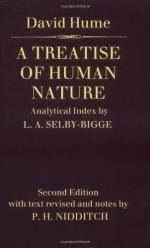|
This section contains 1,101 words (approx. 3 pages at 400 words per page) |

|
Perspective
The perspective of the Treatise of Human Nature is that of its author, David Hume. Hume is one of the great philosophers and perhaps the greatest philosopher of the 18th century. Hume is perhaps the foremost member of what is known as the Scottish Enlightenment. He is one of largest figures in the tradition of British Empiricism. Hume is also something of an iconoclast, a notorious skeptic and opponent to the beliefs of common sense. These biases should be explained in more detail.
First, as a member of the Scottish Enlightenment, Hume is committed to the idea of social, moral, legal and economic evolution. It was the figures of the Scottish Enlightenment who generated the idea of evolution and spontaneous order decades before Darwin. Hume's conception of spontaneous order is most prominent in his discussion of the evolution of justice in Book III, Part II.
Hume is also...
|
This section contains 1,101 words (approx. 3 pages at 400 words per page) |

|




